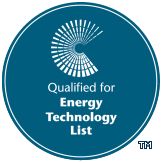It is a common perception that an ecologically efficient building will have a higher up-front cost but saves money through lower operating costs over the life of the building. However, Enhanced Capital Allowances means that going green doesn’t have to be the expensive option.With the early involvement of Coolair & your tax adviser in the initial phases of your building project you can significantly improve cash flow and the opportunity for real after tax savings, by ensuring that as much expenditure as possible qualifies for 100% tax relief.
The scheme
The Enhanced Capital Allowances (ECA) scheme is a key part of the Government ‘s program to manage climate change and provide tax incentives to businesses to encourage investment in energy saving and water efficient equipment. Introduced in 2001, the scheme has since been progressively widened to include additional technologies and a payable tax credit for loss-making companies.
These changes, together with recent reductions in capital allowances writing down allowance rates (to 18% for general plant and machinery and to 8% for expenditure categorized as integral features), mean that incorporating ECA qualifying equipment has become muchy more attractive to businesses undertaking building works on new or existing properties. The cash flow benefit of the 100% first year tax relief for ECA equipment often outweighs any additional cost for it and in any event, there is often no additional cost for specifying ECA compliant equipment.
A bird in-hand
So what is the cash flow advantage? Current rates of capital allowances available for plant and machinery mean that full l tax relief on the expenditure is obtained over a period of around 24 years for general plant, or 56 years for expenditure categorised as integral features. For example, if a large company spends £1 million on a new ECA qualifying air conditioning system for its building during the year ended 31 March 2013, it will obtain a cash flow benefit of £220,800 in the first year when compared with spending £1 million on a similar non-qualifying system. Although the cash-flow advantage reduces over time [56 years in this case), the option of retaining cash to put to good alternative use in the business is clearly very attractive, more
especially in these challenging times.
Payable tax credit
A similar benefit also arises for loss-making companies. Claiming ECAs in companies with tax losses historically had little benefit, effectively removing the tax incentive to invest in E C A equipment. However, the introduction of a payable tax credit in 2008 allows for such companies to surrender an unrelieved loss created by ECAs and to claim a payable tax credit worth up to
19% of the loss created.
Common eligible items
To establish what types of equipment qualify for ECAs, the Government publishes its current full list of approved ECA qualifying equipment at http://www.eca.gov.uk Qualifying products include equipment approved in the following categories:
- Air conditioning
- Air Sourced Heat Pump Boilers
- Lighting
- Efficient toilets/taps/showers
- Pipe work insulation
- Rainwater harvesting
- Ground source heat pumps
- Overhead warm air heating.
How to maximize savings
A key action point when considering ECA qualifying equipment in building projects is to ensure the design team includes such items and that the construction team cannot substitute none qualifying equipment. One of the best ways to manage this is to involve Coolair & your tax adviser in both the design and construction phase of your building project so that they can work with you and your Team to ensure that as much of the building expenditure as possible qualifies for the100% tax relief.
Coolair’s strategy:
Wherever possible we only select units which are A Rated or Higher that are ECA Listed so our customers can benefit from the tax saving and we are able to offer advise at all our branches
